

Jorunn Veiteberg
Thor Brødreskift, courtesy of Heidi Bjørgan
Ceramic artist and curator Heidi Bjørgan's exhibition The Story of an Affair at Nordenfjeldske Kunstindustrimuseum in Trondheim is a complete installation, mixing museum artefacts, music, and scenography with new ceramic works by Bjørgan herself. In this article by art historian Jorunn Veiteberg we're invited to take a closer look at the exhibition as a cabinet of curiosities.
With the exhibition The Story of an Affair, Heidi Bjørgan distinguishes herself to the full as an artist-curator. Oftentimes an exhibition is perceived as a presentation of a series of independent works of art. Interesting visual and thematic connections can arise through the juxtaposition of works, yet without upturning the idea that the exhibition, first and foremost, is about the individual pictures or objects. For this reason, descriptions and analyses of exhibitions are seldom included in encyclopaedic art-historical books. This should change in light of an exhibition practice such as Bjørgan’s. Here the exhibition is the medium. All the objects included in it have become parts of a total installation. In other words, the exhibition has become an artistic expression, and the boundaries between the artist and the curator are erased. In Bjørgan’s case, such a development is unsurprising. Educated as both a ceramist and a curator, she has, in the Norwegian context, been a driving force for exploring the exhibition format.
This started after she graduated from the National College of Art and Design in Bergen in 2000. Together with fellow students Ruth Moen, Anne-Helen Mydland and Anne Thomassen, she established the gallery space Temp in an old store on the street Skottegaten in Bergen. This they ran for two years. Since then, Temp has functioned partly as a curatorial group and partly as an exhibition cooperative. Some of their joint projects leap to mind, such as the installations Temptation Island, made for the exhibition The State of Things (Tingenes tilstand) at the National Museum in Oslo in 2006, and Monochromes from 2010, which is now part of the National Museum’s collection.
Bjørgan’s interest in staging and in creating tableaus or rooms that surprise was demonstrated to the full in her exam project at the end of her curatorial studies: That Was Then…This Is Now, shown at Hordaland Art Centre in 2009. The break with the traditional ‘white cube’ aesthetic that normally characterises this gallery was total. The floor and walls were covered with plywood, a material affecting a complete change in the room’s character. At the Nordenfjeldske Kunstindustrimuseum (the National Museum of Decorative Arts and Design in Trondheim), the two rooms at Bjørgan’s disposal for The Story of an Affair have also been completely changed from their architectural starting point. In front of the window there are heavy and dark curtains, and the walls in one room are covered with wallpaper with Oriental motifs; the second room is painted dark green. The lighting deserves a chapter in its own right. The museum’s spot-lamps have been replaced by the type of spotlights used for theatre and film sets. While the room is shrouded in half-darkness, the lighting draws our attention to the objects spread over tables and shelves and placed in glass cases. Illuminated by the spotlights, they glow and shine.
A Baroque mood pervades The Story of an Affair, created not least by the dramatic lighting and voluptuous scenography. Yet also in the combination of objects, there is a sensory contrast that can be described as Baroque. There where the ceramics from the museum’s own collection are made by men, Bjørgan marks her works to emphasise that they are made by a woman. This comes to expression symbolically, through forms resembling abstracted female genitalia and sucking lips, also by the inclusion of elements of fur. The affair we have been invited to learn about is thus very sensually mediated, even though it concerns a profession-related dialogue more than a physical assignation between lovers.
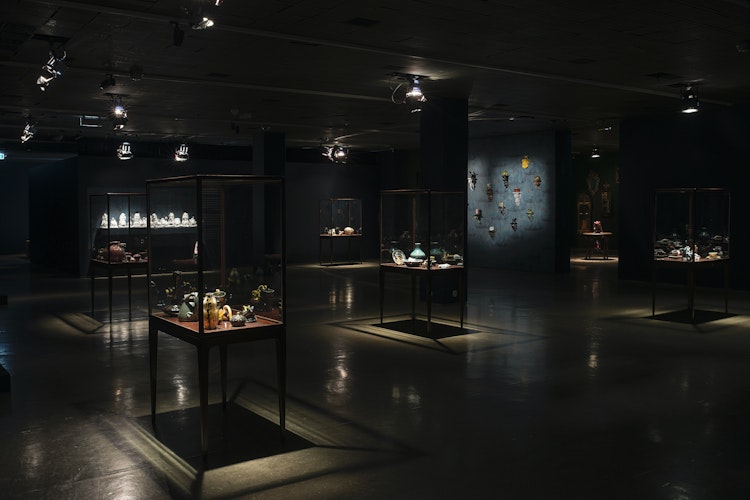
In any case, the museum claims in its introduction that the exhibition title alludes to the artists long-standing love relationship with just this museum. But the exhibition itself divulges that it is a matter of more than an affair. Through juxtaposing her own works with selected objects from the museum’s collection, glowing lines are established between Bjørgan’s works and those made by ceramists from different periods: Trønder ceramics1 and Art Nouveau ceramics, Kähler and Erik Pløen. The museum’s collection is usually organised chronologically according to epochs or styles, but Bjørgan rises above such conventions, mixing objects in ways that cut across time and space.
Her own works also express a strong fascination for the eccentric American ceramist George E. Ohr (1857–1918). He referred to himself as ‘the mad potter of Biloxi’, and when Bjørgan started an (artistic) affair with him a few years ago, it marked a new direction in her art. Ohr’s vases often look like they melted in the kiln, the pots have edges that fold and curl. The metallic and shiny glazes shocked his contemporaries. Like Ohr, Bjørgan challenges conceptions about what good craft is by ‘erasing’ traces of what she learned when studying ceramics. Through being banged and tossed about, the forms thrown on a potter’s wheel become deformed, and she mixes glazes that in theory cannot be mixed. A broken fragment from one work can become part of another. In this way, a tension emerges in the works, between the constructive and the destructive, the beautiful and the ugly.
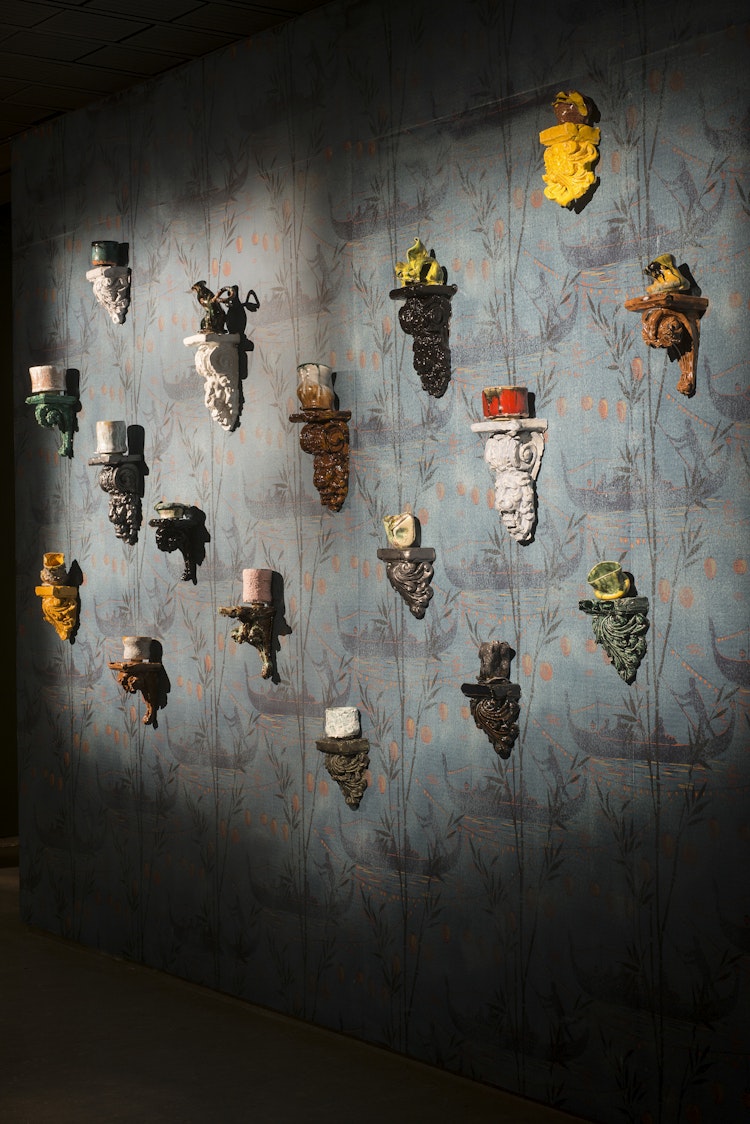
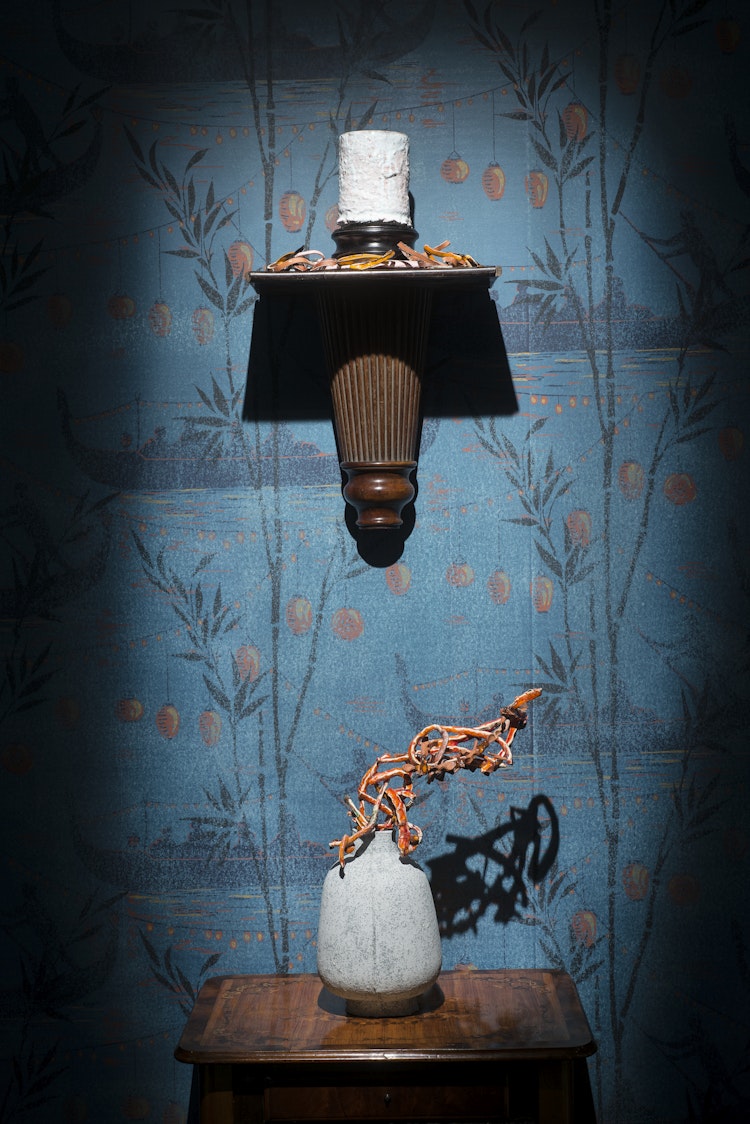
There is a great difference between the two exhibition rooms. The second room has only a few ceramic works, and the walls are covered with old mirrors in non-matching gold frames. In the middle stands a table with a ceramic sculpture Bjørgan found in the museum’s magazine. It shows a bear holding a cub in its mouth, and it is thought to have been made by a Russian artist for the Arabia ceramics factory in Finland in the 1940s. Red dripping ox-blood glaze covers the figure. Associations lead automatically to concepts such as ‘the Russian bear’ and ‘the red scare’. A mysterious and dramatic sculpture, it made a strong impression on Bjørgan when she, as a schoolgirl in the late 1980s, visited the museum’s magazine. On the shelf underneath, there sits one of her own red pots.
When the public enter the mirror room, a sensor is activated and a crackled recording of an old British children’s song starts playing: The Teddy Bear’s Picnic. It’s first line is ‘If you go down in the woods today, you’re sure of a big surprise’. The song plays a key role in Peter Greenaway’s film A Zed & Two Noughts. His films are an important source of inspiration for Bjørgan’s method of making exhibitions. As a trained artist, Greenaway places great emphasis on each scene’s visual qualities, and oftentimes they have a tableau-like character.
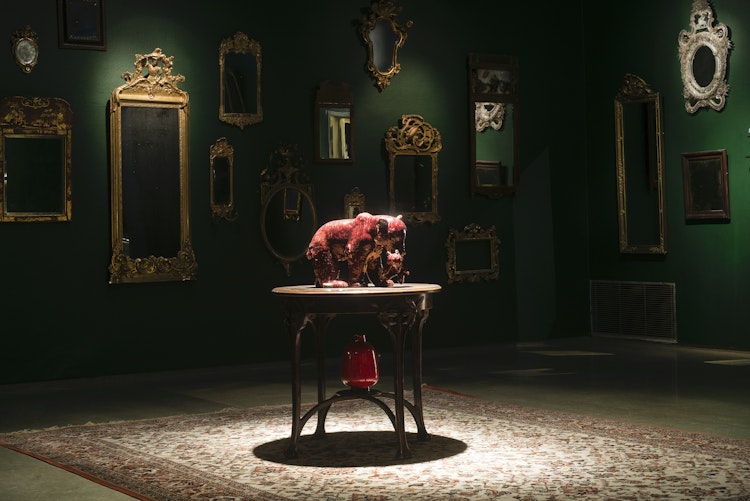
What we can call a theatricalisation of the exhibition medium is nothing new. The Dadaists and Surrealists dealt with it already in the Interwar period, but in later years this type of exhibition has gained new relevance in museums. Filmmakers and theatre directors are often used as curators. In addition to Peter Greenway, it is particularly Robert Wilson who museums have recruited. But other references also emerge when encountering Bjørgan’s exhibition. The Wunderkammer, or cabinet of curiosities, which represents a pre-modernist exhibition practice, is particularly relevant.
The phenomenon of the cabinet of curiosities arose during the Renaissance. In addition to demonstrating princely power and wealth, it contained an amassing of treasures from around the world, things formed by nature, for instance conch shells, fossils and strange fruit, but also manmade masterpieces made in exclusive materials. Amazement over these rare, unusual and often also valuable and important wonders served both as entertainment and as sources of knowledge for how the world perhaps hung together.
As the collections grew, it became common to sort the objects according to type or material, and the cabinet of art thus became the precursor to museums in Europe. Bjørgan has had an especially good eye for the collections of the powerful August the Strong (1694–1733) in Dresden. It was in his realm that Meissen was established, the first porcelain factory in Europe, and in the Zwinger palace we can still today walk from room to room and marvel over the different treasures exhibited on each their own console, set off against a background of mirrors and gold. In Bjørgan’s exhibition we find an echo of this, for there is a wall with vase forms mounted on individual consoles.
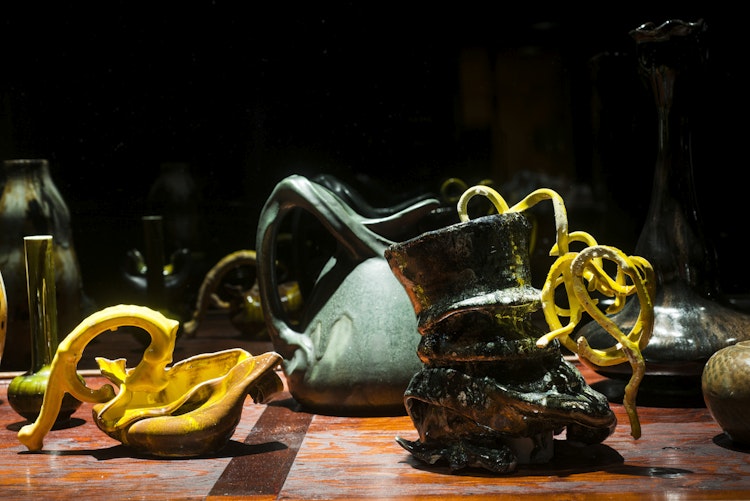
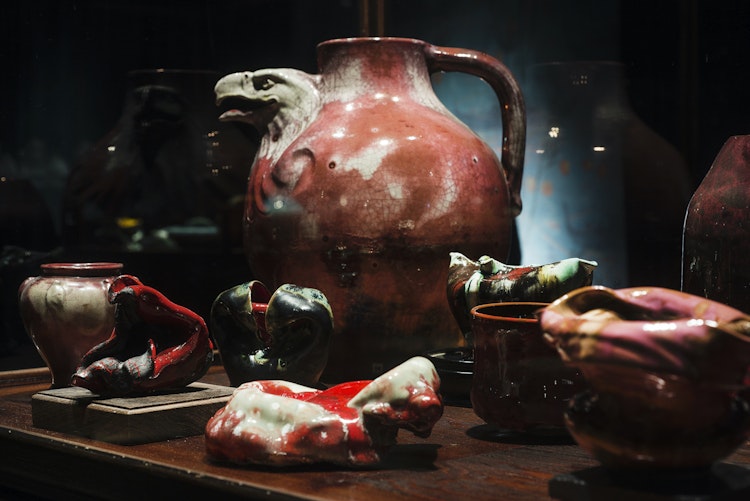
Bjørgan is not the only curator preoccupied with the cabinet of curiosities as an exhibition principle. It undergirded the Brain, which curator Carolyn Christov-Bakargiev defined as the core of Documenta 13 in 2012, and which she described with words such as ‘puzzle’, ‘riddle’ and ‘embodied non-concept’. There is also a clear reference to The Encyclopedic Palace, Massimiliano Gioni’s main exhibition at the Venice Biennale in 2013. One reason why so many curators and artists today borrow from the idea of the cabinet of curiosities is truly that they want to revitalise things by giving them back some of their magic and mystery. The artists and curators want to remind us of the value of the qualities underlying the emergence of the modern museum: curiosity and the desire to collect.
In her encounter with the museum’s collection, Bjørgan has been able to make selections that are steered by her own interests and desires. As an artist, she is not bound by the considerations a professional art historian and museum curator must take. In this there lies one of the values of allowing an artist to dialogue with the collection. The dialogue she is invited to participate in is not formulated in words; it builds instead on the combination of objects and the visual staging. The strength of the artist-curator is precisely the competence which the dual role gives, to exploit the exhibition medium’s sensory potential.